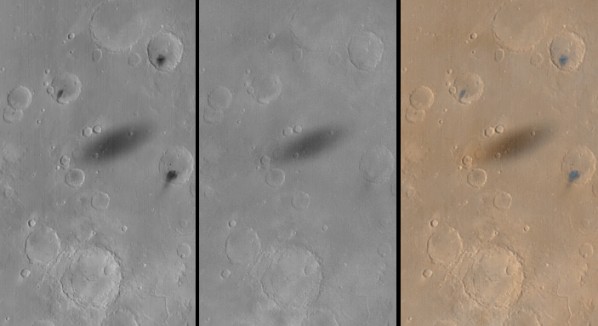
|
Explanation: (xxxedit and linkxxx) Hurtling through space above the Red Planet, potato-shaped Phobos completes an orbit of Mars in less than eight hours. In fact, since its orbital period is shorter than the planet's rotation period, Mars-based observers see Phobos rise in the west and set in the east - traveling from horizon to horizon in about 5 1/2 hours. These three images from the Mars Global Surveyor (MGS) spacecraft record the oval shadow of Phobos racing over western Xanthe Terra on August 26, 1999. The area imaged is about 250 kilometers across and is seen in panels from left to right as red filter, blue filter, and combined color composite views from the MGS wide-angle camera system. The three dark spots most easily seen in the red filter image are likely small fields of dark sand dunes on crater floors. Standing in the shadow of Phobos, you would see the Martian version of a solar eclipse!
|
January February March April May June July August September October November December |
| ||||||||||||||||||||||||||||||||||||||||||||||||
NASA Web Site Statements, Warnings, and Disclaimers
NASA Official: Jay Norris. Specific rights apply.
A service of: LHEA at NASA / GSFC
& Michigan Tech. U.
Based on Astronomy Picture
Of the Day
Publications with keywords: Phobos - Mars - Martian moon - eclipse
Publications with words: Phobos - Mars - Martian moon - eclipse
See also:
- APOD: 2025 September 28 Á Leopard Spots on Martian Rocks
- APOD: 2025 July 15 Á Collapse in Hebes Chasma on Mars
- APOD: 2025 July 6 Á The Spiral North Pole of Mars
- APOD: 2025 June 29 Á Dark Sand Cascades on Mars
- APOD: 2025 June 22 Á A Berry Bowl of Martian Spherules
- APOD: 2025 June 15 Á Two Worlds One Sun
- Perseverance Selfie with Ingenuity
